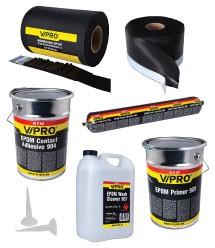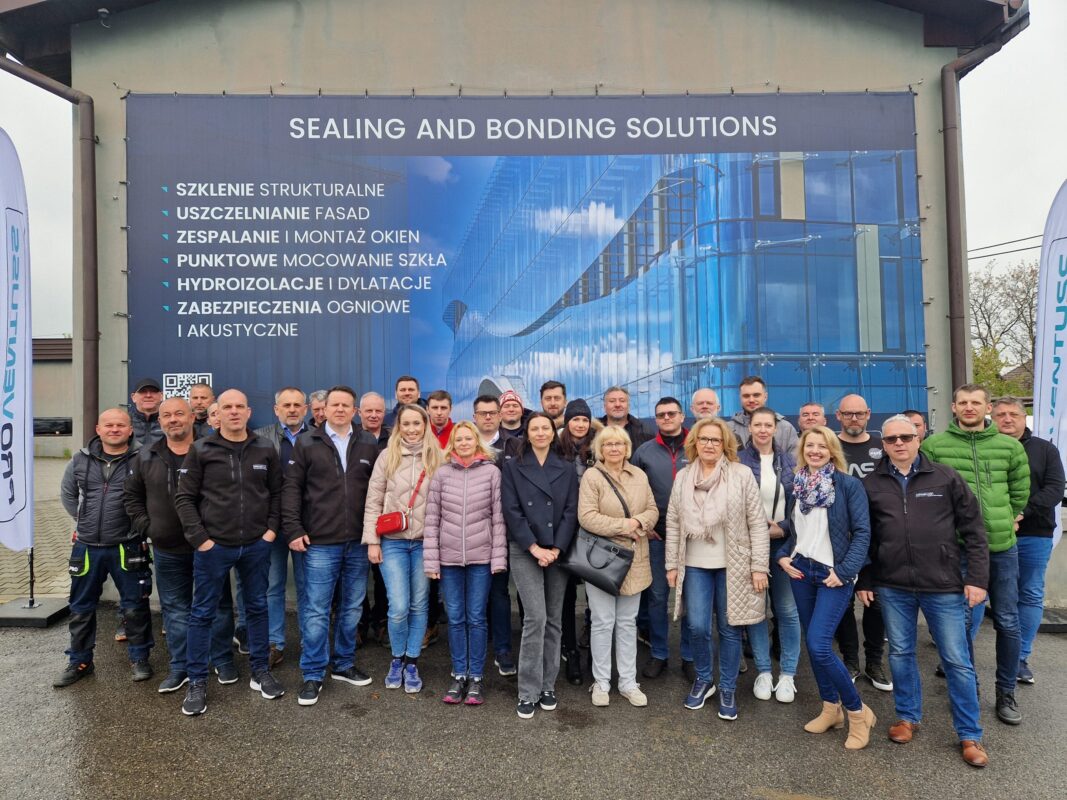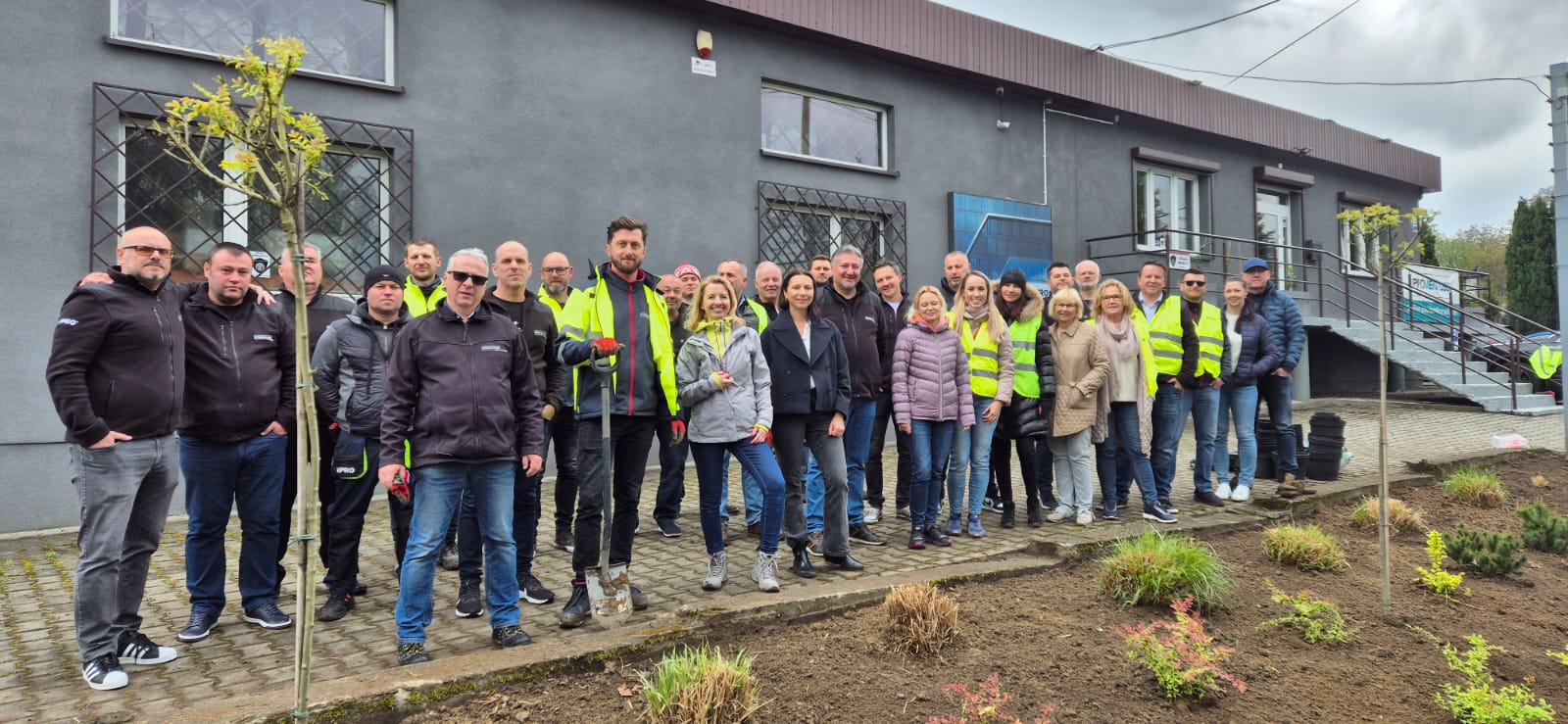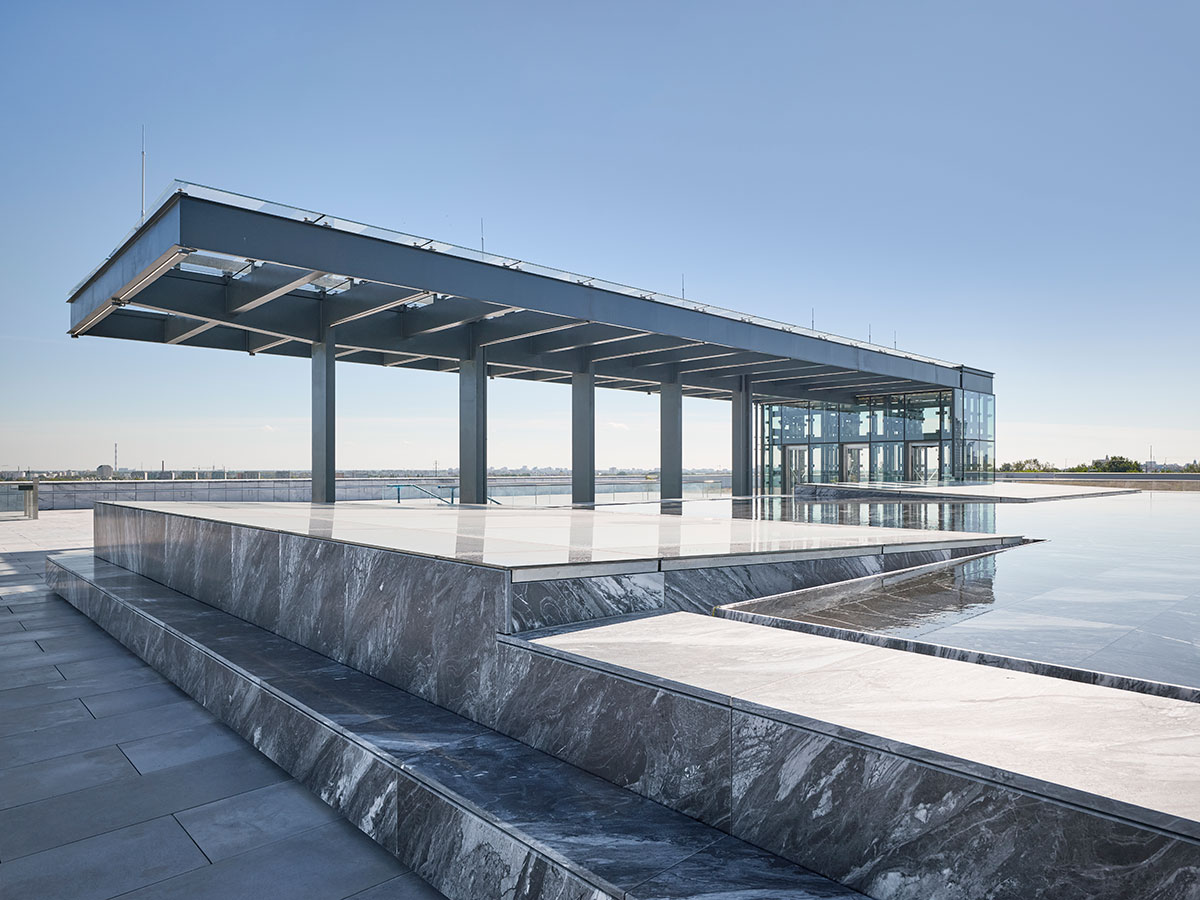Throughout its lifetime, the building has been under the influence of thermal and structural displacements, and it is also influenced by wind and water, all within a wide temperature range and various climatic conditions. Due to these stresses and movement, waterproofing insulation must meet certain requirements: it must be durable, flexible, waterproof and tear-resistant.
VI-PRO® EPDM membranes are ideal for sealing window joinery assembly from the inside and outside of the window. They are intended for both large and smaller areas, so they are perfect as damp insulation for larger industrial buildings or single-family houses.
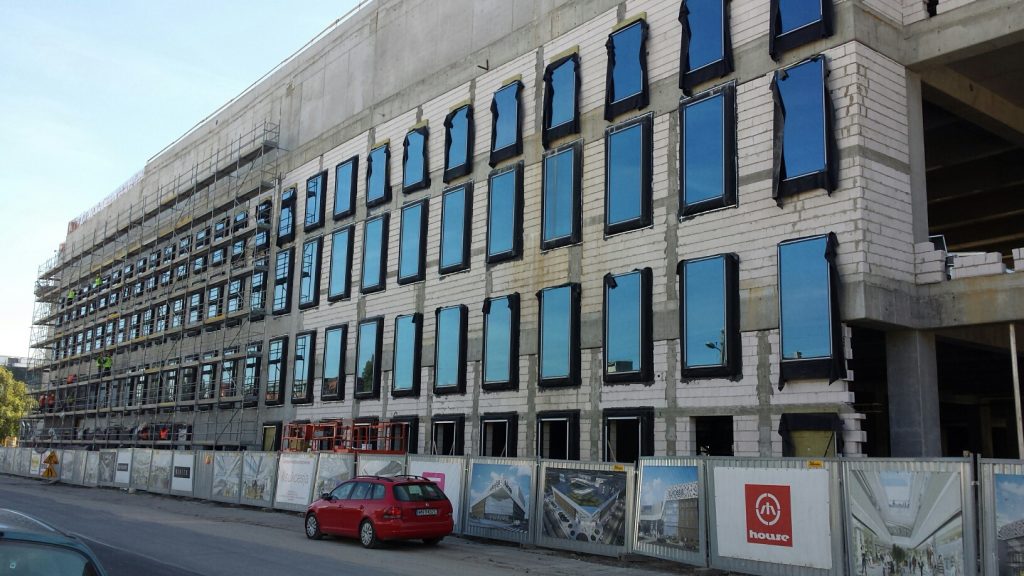
CORRECT INSTALLATION OF EPDM MEMBRANES
In accordance with the provisions of the Technical Conditions to be met by buildings, as well as the current state of technical knowledge, it is known that the joints of windows with jambs should be made in a tight manner. The basic rule is “tighter inside than outside.” The need to use a highly airtight membrane results from the need to limit the flow of moisture from the building to the thermal insulation around the window, while any moisture present in this place should be able to “escape” to the outside. Due to this, there are two basic types of membranes for indoor and outdoor use.
From this point of view, the most important parameter of EPDM membranes is the diffusion resistance factor µ – also known as the water vapor transmission coefficient. Often the parameter Sd = (equivalent) diffusion air thickness is used to compare EPDM membranes. It determines the vapor permeability of a material by comparing its diffusive properties to that of a layer – the thicker it is, the more difficult water vapor passes through the air. Thus, the Sd coefficient determines the diffusion properties of a layer of building material of a given thickness by comparing them to the thickness of an air layer of the same diffusion resistance – therefore the dimension of this coefficient is a meter.
From this factor we are able to calculate the parameter Sd for any membrane thickness, Sd = µ x d.
Example 1. An EXT outer membrane with a thickness of 0.75 mm and µ = 32,000 will have an Sd = 32,000 * 0.00075 = 24m coefficient.
Example 2. An INT Super inner membrane with a thickness of 0.75 mm and µ = 300,000 will have an Sd = 300,000 * 0,00075 = 225 m.
As can be seen from the examples above, the water vapor permeability of the outer and inner membrane can be over 9 times higher for the same membrane thickness!
STRENGTH VI-PRO ® EPDM MEMBRANES
The strength and flexibility of the membranes remain unchanged for decades without any signs of shrinkage, melting, hardening or cracking. The membrane remains flexible at the temperature from –40 to + 120˚C. The service life of EPDM, defined as a minimum of 150% elongation at break, is over 50 years in exposed (outdoor) installations. EPDM and Butyl are also highly resistant to chemicals, attacks by rodents, fungi, bacteria and microorganisms. EPDM does not absorb water. EPDM and Butyl have the ability to compensate for thermal and structural movements of the substrate thanks to the linear elongation in the product plane, reaching 300% and over 100% in other directions and at all temperatures. Unlike many thermoplastic materials, EPDM does not have a clear yield point, deformed to the extreme, it will always return to its original shape, size and thickness.
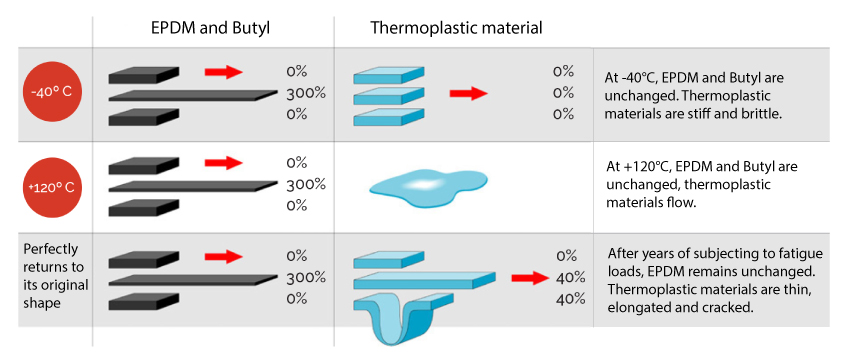
ADVANTAGES OF VI-PRO® EPDM SYSTEM
- Resistance to weather conditions, pollution, UV radiation. The expected service life exceeds 50 years.
- Temperature resistance. It maintains flexibility and elasticity regardless of the temperature.
- Biological resistance. Resistant to microbiological degradation, rodents, fungi and bacteria.
- Flexible. Possible elongation in the elastic range exceeding 300% in the plane of the product and over 100% in other directions. In practice, it will always return to its original shape and transfer the thermal and structural movements of the substrate.
- Many years of history. EPDM and Butyl membranes have been used in construction and industrial engineering for over 50 years. They are the most flexible membranes in the history of construction.
- Durable and puncture resistant. It is not subject to mechanical influences or extreme pressures
- Resistance to contact with other building materials. EPDM and Butyl do not contain plastics or additives that migrate to other building materials. They are not affected by other building materials and do not cause chemical aggression with the building substrate.
- Resistant to water and moisture. EPDM and Butyl are completely resistant to water and moisture.
- Environmentally friendly product. It does not contain any substances polluting the environment. It is recyclable, it can be burned without harming the environment.
- A developed, complete facade system. All materials and a range of technical solutions from one supplier.
A WIDE RANGE OF VI-PRO ® EPDM MEMBRANES
VI-PRO® EPDM SYSTEM offers three types of membranes with different water vapor permeability coefficients. VI-PRO® EPDM Membrane EXTERNAL is used externally where a high rate of vapor permeability is required. VI-PRO® EPDM Membrane INTERNAL, Membrane INTERNAL SUPER, Membrane Butyl Layer are used where low or very low vapor permeability is required.

VI-PRO ® EPDM MEMBRANE EXTERNAL
EPDM is a waterproof elastomeric belt made of synthetic rubber with a low water vapor diffusion resistance coefficient. It is black and the surface of the membrane has the texture of a textile print on both sides to ensure maximum adhesion.
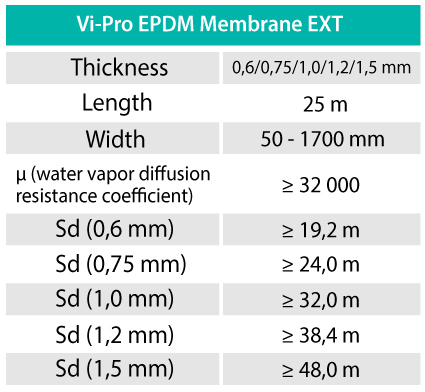
VI-PRO ® EPDM MEMBRANE INTERNAL
VI-PRO® EPDM Membrane INT is a waterproof elastomeric belt made of synthetic rubber with an average coefficient of resistance to water vapor diffusion. It is black and the surface of the membrane has the texture of a textile print on both sides to ensure maximum adhesion.
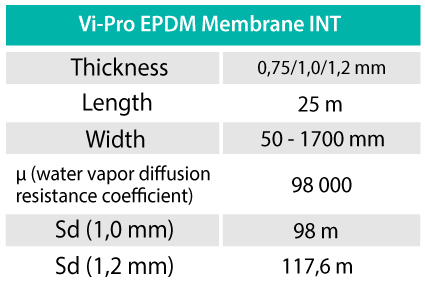
VI-PRO ® EPDM MEMBRANE INTERNAL SUPER
EPDM is a waterproof elastomeric belt made of synthetic rubber with a high coefficient of resistance to water vapor diffusion. It is black and the surface of the membrane has the texture of a textile print on both sides to ensure maximum adhesion.

VI-PRO ® EPDM MEMBRANE BUTYL LAYER
VI-PRO® EPDM Membrane Butyl Layer is a 1.6mm thick self-adhesive EPDM façade sealing strip. The thickness of the EPDM layer is 1.0 mm and it contains a polyester textile insert. The bottom side is a layer of 0.6 mm sticky butyl and a tape securing the adhesive surface, which gives a product with a high coefficient of resistance to water vapor diffusion. VI-PRO® EPDM Membrane Butyl Layer is available in black.
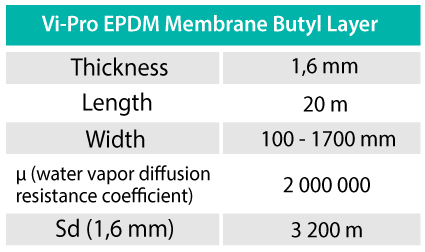
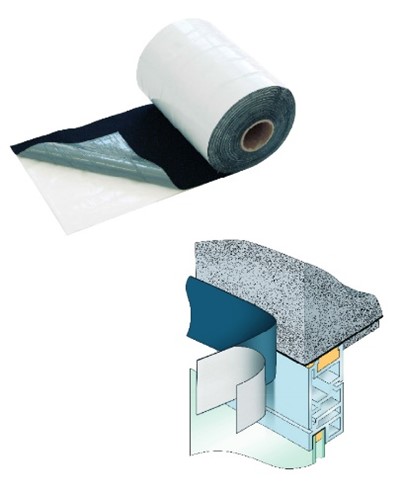
VI-PRO ® EPDM MEMBRANE BUTYL STRIPS
VI-PRO® EPDM Membrane Butyl Strips is a waterproof elastomeric belt made on the basis of synthetic rubber with a low coefficient of resistance to water vapor diffusion. It is black and the surface of the membrane has the texture of a textile print on both sides to ensure maximum adhesion.
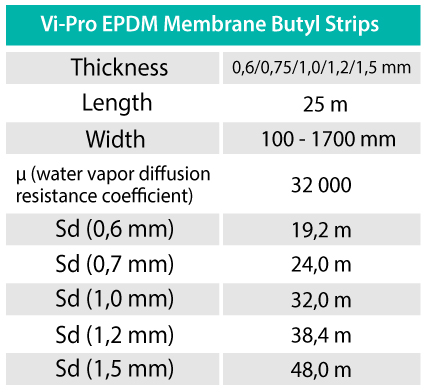
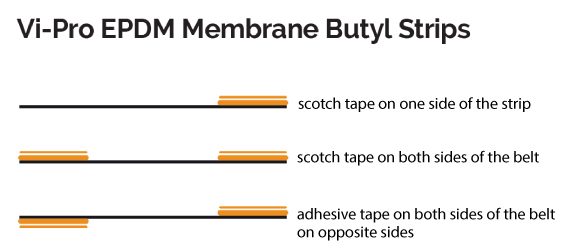
VI-PRO® EPDM MEMBRANE CLICK
VI-PRO® EPDM Membrane Click is a waterproof elastomeric strip made of synthetic rubber with a low water vapor diffusion resistance coefficient with an EPDM gasket on one side. The EPDM gasket is matched to the existing system of aluminum or PVC profiles. Mechanical fastening by attaching the clasp to the linear cutter on one side of the structure and gluing on the other. It is black and the surface of the membrane has the texture of a textile print on both sides to ensure maximum adhesion.
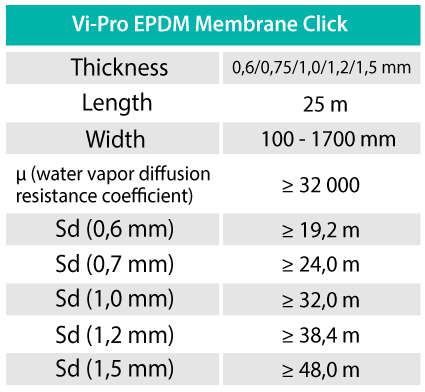
VI-PRO ® EPDM SYSTEM ADHESIVES AND PRIMER
Five alternative application methods allow us to find a solution for each facade, window or structure, taking into account each type of structure.
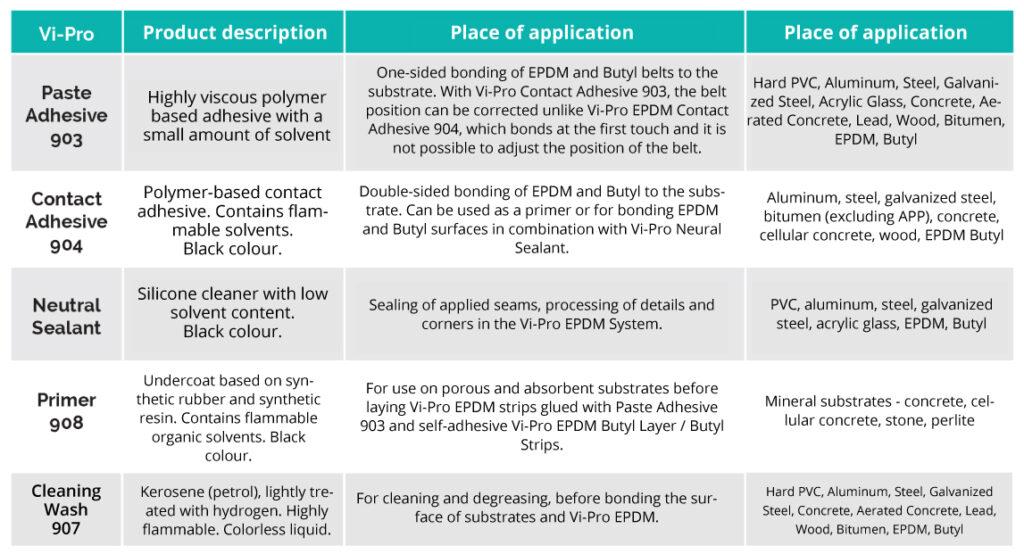
VI-PRO ® EPDM CONTACT ADHESIVE 903 ADHESIVE is available in a tube type packaging – 600 ml. It should be applied to the substrate with a hand gun or a spatula. Consumption 10-12 m / pc. Packing 12 pcs / carton.
VI-PRO ® EPDM CONTACT ADHESIVE 904 ADHESIVE packed in 4.2 kg cans. Before use, mix the glue thoroughly. Use a brush or a solvent-resistant roller to cover the surfaces of both surfaces to be glued (belt and substrate). When the surfaces are dry to the touch after approx. 10-15 minutes, they should be joined and pressed. Consumption: 0.5 kg / m2.
VI-PRO® NS NEUTRAL SILICONE is a silicone sealant with excellent adhesion to synthetic rubber and most construction substrates. VI-PRO® NS Neutral Silicone is available in 600 ml foils.
VI- PRO® EPDM PRIMER 908 primer on a polymer basis for the preparation of substrates to improve adhesion of adhesives. Packaging: 6 l metal cans. Consumption: approx. 3 m2 / liter.
VI-PRO® EPDM WASH CLEANER 907 Technical petrol, lightly treated with hydrogen, colorless. For cleaning and degreasing before bonding substrates and EPDM surfaces. Consumption 4-5 m2 / L. Packaging: 5L canister.
